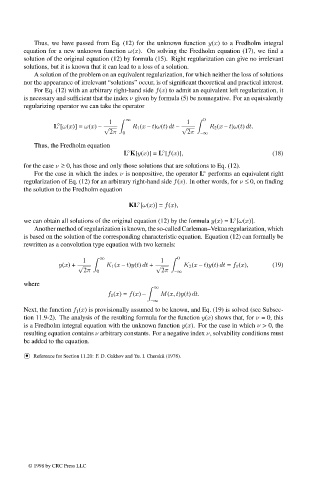Page 613 - Handbook Of Integral Equations
P. 613
Thus, we have passed from Eq. (12) for the unknown function y(x) to a Fredholm integral
equation for a new unknown function ω(x). On solving the Fredholm equation (17), we find a
solution of the original equation (12) by formula (15). Right regularization can give no irrelevant
solutions, but it is known that it can lead to a loss of a solution.
A solution of the problem on an equivalent regularization, for which neither the loss of solutions
nor the appearance of irrelevant “solutions” occur, is of significant theoretical and practical interest.
For Eq. (12) with an arbitrary right-hand side f(x) to admit an equivalent left regularization, it
is necessary and sufficient that the index ν given by formula (5) be nonnegative. For an equivalently
regularizing operator we can take the operator
∞ 0
1 1
◦
L [ω(x)] ≡ ω(x) – √ R 1 (x – t)ω(t) dt – √ R 2 (x – t)ω(t) dt.
2π 0 2π –∞
Thus, the Fredholm equation
L K[y(x)] = L [f(x)], (18)
◦
◦
for the case ν ≥ 0, has those and only those solutions that are solutions to Eq. (12).
For the case in which the index ν is nonpositive, the operator L performs an equivalent right
◦
regularization of Eq. (12) for an arbitrary right-hand side f(x). In other words, for ν ≤ 0, on finding
the solution to the Fredholm equation
◦
KL [ω(x)] = f(x),
◦
we can obtain all solutions of the original equation (12) by the formula y(x)= L [ω(x)].
Another method of regularization is known, the so-called Carleman–Vekua regularization, which
is based on the solution of the corresponding characteristic equation. Equation (12) can formally be
rewritten as a convolution type equation with two kernels:
0
1 ∞ 1
y(x)+ √ K 1 (x – t)y(t) dt + √ K 2 (x – t)y(t) dt = f 1 (x), (19)
2π 0 2π –∞
where
∞
f 1 (x)= f(x) – M(x, t)y(t) dt.
–∞
Next, the function f 1 (x) is provisionally assumed to be known, and Eq. (19) is solved (see Subsec-
tion 11.9-2). The analysis of the resulting formula for the function y(x) shows that, for ν = 0, this
is a Fredholm integral equation with the unknown function y(x). For the case in which ν > 0, the
resulting equation contains ν arbitrary constants. For a negative index ν, solvability conditions must
be added to the equation.
•
Reference for Section 11.20: F. D. Gakhov and Yu. I. Cherskii (1978).
© 1998 by CRC Press LLC
© 1998 by CRC Press LLC
Page 596

